Analyze Major Changes and Continuities in the Social and Economic Experiences of African American
 | The Washington Family Group c. 1870 Gift of Paulette Warner |
Ex-slaves also sought opportunities by moving from rural to urban areas. The black population in Baton Rouge nearly doubled between 1860 and 1870, with the number of African Americans in New Orleans more than doubling. The number of whites during the same years decreased.
Large numbers of blacks moving to the cities put pressure on available housing, services, and jobs and intensified the racial and class tensions of the Reconstruction period.
Labor and Land
The violence, destruction, and economic uncertainty that accompanied the Civil War and Reconstruction destroyed many Louisiana plantations and their owners' fortunes, with the loss of capital by southern white and free black planters estimated at $500 million. Union and Confederate armies bombarded and occupied plantation homes and outbuildings. Many planters deserted their homes or stayed but could not afford to maintain them according to antebellum standards. Those who managed to regain their land from Union officials found that declining land values made it almost worthless.
Auctions were held throughout Louisiana during Reconstruction to sell off plantations their owners could no longer afford. Travelers to the state, like Edward King, a writer for Scribner's Monthly, noted the declining fortunes, and consequent hospitality, of Louisiana planters:
- There was no longer the spirit to maintain the grand, unbounded hospitality once so characteristic of the South. For it was a grand and lordly life, that of the owner of a sugar plantation; filled with culture, pleasure, and the refinement of living;-- but now!
Once freed, many African Americans tried to acquire land of their own and work it with their reunited families. Government promises of "forty acres and a mule" raised hopes that went mainly unfulfilled. Ten years after emancipation barely five percent of former slaves in Louisiana and other ex-Confederate states owned their own land, and those who did lacked the capital and credit to develop it.
Agricultural and Technological Innovations
Many large Louisiana sugar plantations were broken down into smaller units following the Civil War. Owners or tenants of these smaller holdings pooled their resources for the upkeep of one mill used by all, as they could not afford to build and maintain individual sugar mills.
The marketing of cotton became increasingly decentralized in the postwar years, with growing numbers of farmers selling their cotton to traders and peddlers insteading of conducting business with high-paid factors or commission merchants in New Orleans. Many of these country traders were Jews who had connections with Jewish mercantile communities in New Orleans and New York. In 1871 cotton producers and merchants formed the New Orleans Cotton Exchange to transform postbellum marketing into a more efficient and profitable enterprise.
| | Cotton Exchange Building 1873 From Jewell's Crescent City Illustrated |
The first successful commercial manufacturing of ice in the United States took place in Louisiana during Reconstruction. In 1868 the first plant to make ice on a regular basis opened in New Orleans. Louisianians used much of this product to keep their food and beverages cool.
Edmund McIlhenny produced the first bottles of Louisiana's famous Tabasco brand pepper sauce in 1868. The rice and sugar crops near Avery Island had been destroyed by constant skirmishes during the war, and peppers were all that remained in the fields. McIlhenny used these peppers and the abundant salt found at Avery Island to create a spicy seasoning that enlivened the drab postwar fare most Louisianians were forced to eat.
Social Diversions
For most Louisianians, rich and poor, black and white, social diversions remained the same, before, during, and after the war. Resistant to change, white social leaders made northern officials and businessmen conform to Louisiana customs.
Popular in antebellum times, opera and theater continued to attract audiences during occupation and Reconstruction. In addition, traveling theatrical groups followed the rural town circuit and occasionally played in New Orleans and Baton Rouge. Although considered "places of public character" according to Article 13 of the 1868 constitution, which forbade racial discrimination, operas and theaters retained racially segregated seating patterns.
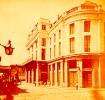 | New Orleans Opera House Samuel T. Blessing c. 1885 |
Louisianians kept their love for dance alive, even in the most troubled of times. Like most recreational activities, the best-attended dances took place on Sundays. Louisianians hosted masquerade balls during the carnival season and masked and noncostume balls throughout the year. As with opera houses and theaters, most dancehalls and other dancing sites were segregated by race.
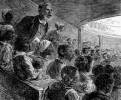 | The Negro Gallery July 15, 1871 Reproduced from Every Saturday Gift of the Louisiana Museum Foundation |
Even with resources reduced by the Civil War and Reconstruction, Louisianians loved to shop. For those of high standing, both black and white, shopping was more of a social than an economic activity, a time to see old friends and make new ones, to show off new clothes, carriages, and servants, and to watch all the other people browsing from store to store.
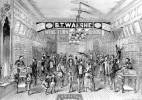 | Interior View, B. T. Walshe Clothing Store 1873 Reproduced from Jewell's Crescent City Illustrated |
Their love for fine food also undiminished by economic woes or Reconstruction politics, residents and visitors to Louisiana continued to keep its many fine restaurants in business.
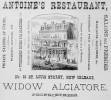 | Advertisement for Antoine's Restaurant 1878 From Soard's New Orleans City Directory Antoine's Restaurant, established during the antebellum period and still in operation today, is one of the oldest restaurants in the country. |
As they had in the antebellum period, Louisianians and their guests took evening strolls along the levees adjoining rivers, canals, and bayous. They also promenaded through parks and streets. Residents in both cities and the countryside visited the houses and plantations of relatives and friends.
 | Fashionable African-American Women Edouard Marquis 1867 Gift of Mr. J. Lawrence |
In 1874 the design of women's clothing changed dramatically--from the short-waisted, voluminous skirts draped over extraordinarily large hoops to long-waisted, tight fitting bodices attached to slim skirts with bustles in the rear.
Birth of the Octopus: Louisiana State Lottery Company
Reputed to be one of the largest privately owned businesses in United States history, the Louisiana State Lottery Company operated legitimately between 1868 and 1893. In 1868 Louisiana's newly reconstructed legislature approved organization of "the company," as it was called, and chartered it for twenty-five years. The lottery company was exempt from taxes and licensing fees but made annual payments of $40,000 to the state treasury. This money funded public education and health care, one of the major recipients being Charity Hospital in New Orleans.
The company held daily, monthly, and semi-annual drawings. Former Confederate generals P. G. T. Beauregard and Jubal Early promoted and gave integrity to the drawings. Set on a large stage, blindfolded boys removed tickets and prizes wrapped in cylinders from two wheels at the same time. One boy pulled a winning ticket from the large drum and handed it to General Early, where it was matched with the prize ticket that another boy pulled from the small wheel and handed to General Beauregard. Early announced the winning numbers and Beauregard the amount won.
 | State Lottery Building 1873 Reproduced from Jewell's Crescent City Illustrated The lottery building was located on the corner of St. Charles and Union streets in New Orleans. |
The lottery's heyday came in the 1880s. In 1890 the company's estimated gross earnings exceeded $28 million. Because its influence reached throughout the entire North American continent, the Louisiana State Lottery Company earned the nickname of the "Octopus." The United States postal system allowed people from all over the country to purchase tickets in the hope of striking it rich.
The Louisiana State Lottery Company held its final drawing in December 1893. Murphy J. Foster, the Louisiana governor from 1892 to 1900, led the attack on the company, which faced growing national and state opposition to lotteries and other forms of organized gambling. The 1892 state legislature prohibited lottery operations, and that same year the United States Supreme Court upheld a law that banned the mailing of lottery tickets and bulletins. The company then moved to Honduras and continued to run illegal lotteries in the United States until the early 1900s.
Mardi Gras
Although Comus, the oldest of Mardi Gras organizations, suspended operations from 1862 through 1865, Louisianians resumed their Mardi Gras celebrations during Reconstruction.
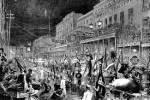 | Mardi Gras Celebration in New Orleans, Tuesday March 6--Procession of the "Mistick Krewe of Comus" April 6, 1867 From Frank Leslie's Illustrated Newspaper |
During Reconstruction several new practices made their way into New Orleans's traditional Mardi Gras lore. In 1870 the Twelth Night Revelers first appeared and two years later a group of businessmen and civic leaders invented Rex, the king of Carnival, choosing Louis J. Salomon as their first monarch.
The crowds that gathered to watch the parades were made up of all races and classes. Writing in 1874, Edward King applauded Mardi Gras in New Orleans:
- White and black join in its masquerading, and the Crescent City rivals Naples in the beauty and richness of its displays.
Reforms in Education
Important reforms in education took place in Louisiana during Reconstruction. The Constitution of 1868 provided for at least one free public school in each parish, with students age six to eighteen admitted regardless of race. Within five years after the 1868 constitution, the Louisiana school system increased from 100 public schools in the state to over 1,100.
The Louisiana school system was not perfect under Reconstruction administrations, with inadequate funding for buildings, books, and teachers, but it was much better than the one that followed in the years after Reconstruction. After 1877 segregation returned to the system, with very few schools for African Americans. During Reconstruction all-black and mixed public schools flourished, while attendance at white schools dropped.
 | Rebecca, Augusta, and Rosa Kimball, New York 1863 To raise money for newly created schools for emancipated slaves, cartes-de-visite like this one were sold in northern states. |
Money from the John McDonogh estate significantly aided the New Orleans public school system. McDonogh was a wealthy commission merchant, planter, and real estate speculator who died in 1850 and left most of his estate to the cities of New Orleans and Baltimore for education purposes. New Orleans administrators established the first McDonogh School in the antebellum period and McDonough Schools two through six during Reconstruction. Both black and white students attended these schools, fulfilling McDonogh's wish that black New Orleanians share his legacy.
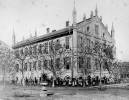 | McDonough School No. 6 1904 |
Most teachers in Louisiana public schools were white and southern born, but some African Americans and northerners also taught here. There was very little integration in schools outside New Orleans, and many whites in both rural and urban areas refused to send their children to schools with either black children or black teachers.
Administrators established teaching schools and other institutions of higher education for African Americans during Reconstruction. Schools were set up in New Orleans, Shreveport, Baton Rouge, Amite, and other sites around the state to train black teachers. Authorities also established the racially integrated Agricultural and Mechanical College in 1874. In 1877, after Reconstruction, the college merged with the all-white Louisiana State University.
Two additional universities, which were more like modern-day high schools, educated Louisiana blacks during Reconstruction and beyond. The Congregationalist American Missionary Association established Straight University in 1869, which merged in 1935 with New Orleans University to become today's Dillard University. In 1871 the American Baptist Home Missionary Society founded Leland University in New Orleans. Leland had an integrated faculty as well as student body.
The long tradition of support for parochial and private schools continued in Louisiana during Reconstruction, boosted by white opposition to integrated public schools. The number of private schools climbed dramatically in New Orleans between 1864 and 1877, and in Baton Rouge both during and after the war, the majority of white children attended private schools.
johnsonsuccionoth.blogspot.com
Source: https://www.crt.state.la.us/louisiana-state-museum/online-exhibits/the-cabildo/reconstruction-change-and-continuity-in-daily-life/index
0 Response to "Analyze Major Changes and Continuities in the Social and Economic Experiences of African American"
Post a Comment